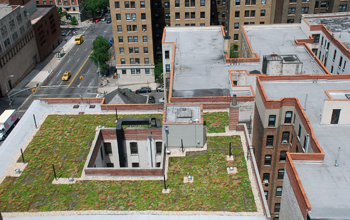Multimedia Gallery
Green Roof Study in New York City (Image 1)
A green roof in New York City, constructed as part of an ongoing study by researchers at Columbia University and the Earth Institute. Information gleaned from the study will be used to help develop the best strategies for the design and spatial distribution of urban green roofs in the future. (Date of Image: 2010) [Image 1 of 4 related images. See Image 2.]
More About This Image
To better understand urban green roof behavior, a team of researchers at Columbia University, in partnership with Columbia's Office of Environmental Stewardship and the Earth Institute's Urban Design Lab, coordinated the building of a number of green roofs throughout New York City.
Green roofs are an environmental system in which plants are grown on a roof's surface to provide natural insulation, absorb rain water--thus reducing the need for costly drainage systems, and provide green space for city-dwelling people and animals. The concept of green roofs has been around for centuries in Europe but has taken off slowly in the U.S. since the 1960s.
Green roofs are built in layers that consist of the following: Specialized waterproofing, root-resistant materials, drainage and/or water storage, and a growing medium such as rocks or soil. All of the layers support carefully selected rooftop plants. The vegetation and soil act like a sponge, absorbing and filtering water that would normally pour down gutters and wash through the streets below.
In any city, most roofs are made of asphalt or black tar or are gravel-ballasted. Dark roofs radiate and/or trap heat, increasing urban heating. Some U.S. cities offer incentives for building green roofs, with the notion they are beneficial for the city. However, a clearer understanding and further information is needed regarding how the roofs perform under natural conditions.
In response to this need, the researchers from Columbia and the Earth Institute initiated the building of a number of green roofs in New York. The researchers measured roof runoff, plant evapo-transpiration, carbon dioxide flux, temperature of the growing medium, moisture gradients, local particle counts, and roof albedo for roofs across the city.
Findings from the study as of summer 2013 confirm the multiple environmental co-benefits of green roofs to the point that they should be considered a proven, viable new green "infrastructure" technology available for adoption in urban areas. Their cost-benefit ratios will undoubtedly improve over time and in some cases, such as combined-sewage overflow (CSO) mitigation, may already be one of the most cost-effective approaches compared to more traditional "gray infrastructure" approaches, such as enormous storm water detention tanks.
Green roofs are also effectively reducing vertical summer and winter rooftop heat flows, as well as eliminating the searing surface temperatures of dark asphalt roofs, which can exceed 170 degrees Fahrenheit during the daytime. The research is ongoing and will look at issues like design improvements, ecosystem benefits and water quality benefits, among other questions.
The information gleaned from this study will be used to help develop the best strategies for the design and spatial distribution of urban green roofs and will provide scientific guidance to the green roof industry, government, local communities and other urban stakeholders in the development of green roof technologies, design and placement strategies. [Research supported by National Science Foundation grant CMMI 09-28604.]
Credit: Stuart Gaffin and Shaily Kedia, Center for Climate Systems Research, Columbia University
See other images like this on your iPhone or iPad download NSF Science Zone on the Apple App Store.
Images and other media in the National Science Foundation Multimedia Gallery are available for use in print and electronic material by NSF employees, members of the media, university staff, teachers and the general public. All media in the gallery are intended for personal, educational and nonprofit/non-commercial use only.
Images credited to the National Science Foundation, a federal agency, are in the public domain. The images were created by employees of the United States Government as part of their official duties or prepared by contractors as "works for hire" for NSF. You may freely use NSF-credited images and, at your discretion, credit NSF with a "Courtesy: National Science Foundation" notation.
Additional information about general usage can be found in Conditions.
Also Available:
Download the high-resolution JPG version of the image. (1.3 MB)
Use your mouse to right-click (Mac users may need to Ctrl-click) the link above and choose the option that will save the file or target to your computer.



